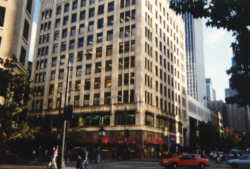|
|
During the earliest stages of development of the BAS system, we committed our product to 5 primary design criteria: 1. Minimum of hardware - One model controller to be used for all control applications. Chillers, boilers, VAV zone dampers, heat pumps, lighting control panels - all HVAC equipment, energy using equipment, and auxiliary devices could be operated from a common controller. Every controller will include the software necessary for all supported equipment. The user selects the appropriate Equipment Schedule with dip switches on the controller 2. System hardware shall conform to open standards - Off-the-shelf PCs shall be used to manage the EMCS network while also serving as the user interface. Software running on the PC shall perform the same network management functions as the expensive, proprietary hardware found in other systems. All inputs and outputs utilize proven technology such as RS-485 for communications, 4-20 mA or 0-5 VDC for analog inputs, and 4-20 mA or 0-10 VDC for analog outputs. 3. Utilize a standard, commercially available operating environment - Microsoft Windows, in addition to meeting this requirement, also offers several advantages. Because BAS was designed to take full advantage of the Windows multitasking environment, the PC used to manage the EMCS can also be used for other tasks. BAS also takes full advantage of Windows data sharing capabilities. Data from trend log files can be pasted to other applications through the Windows Clipboard. BAS fully supports Dynamic Data Exchange (DDE). DDE, included in many commercial Windows applications, can be used to retreive data and share information with BAS. Macros can be easily developed with Microsoft Excel to analyze system data or create custom charts and graphs. Because Energy Zone uses the standard Windows interface, the learning time for building operators is reduced. When a controller is first connected to the system it is identified by the PC, which then auto-configures the equipment based on the Equipment Schedule dip switch setting. 4. Every site shall be provided with all tools necessary to monitor, manage, and modify system operation - All system operation can be fully controlled and modified using the software provided with each system we sell. BAS does not force the user to be dependent on factory engineers and technicians using proprietary software compilers and development systems. With BAS the building operator is fully independent. All control parameters can be modified by simple fill-in-the-blank and point-and-click configuration screens. This architecture is very common in Windows programs, but rarely if ever found in control systems other than BAS. 5. Be competitively priced - The system, including hardware, software, and installation must be priced at or below the cost of any competitive system currently on the market. These features made us unique in the marketplace with our first Energy Zone installation in 1988, and still clearly differentiate us from our competition today. We remain committed to these design criteria now and in the future. No other control system offers the combination of price, features, and performance offered by Energy Zone. | ||||
| © 1988-2014 Enertec-BAS Corporation All rights reserved. |

